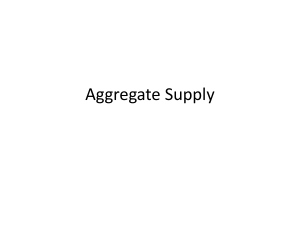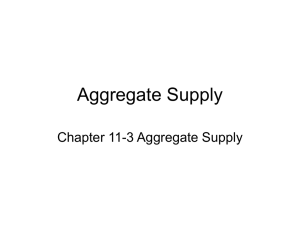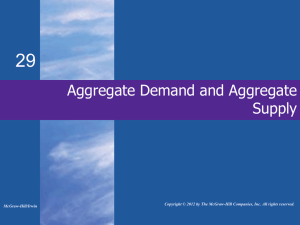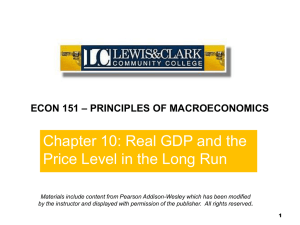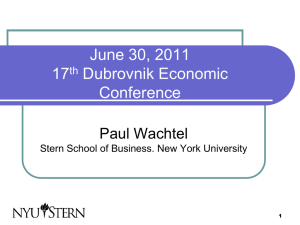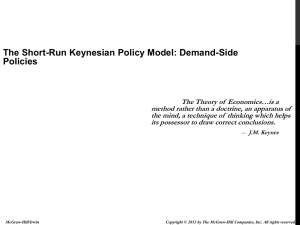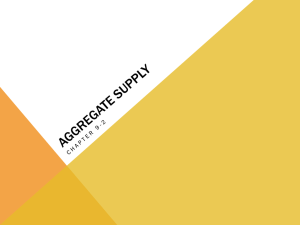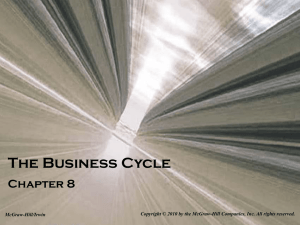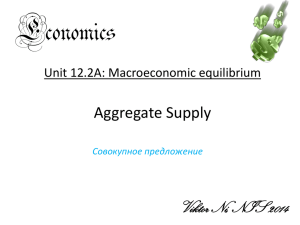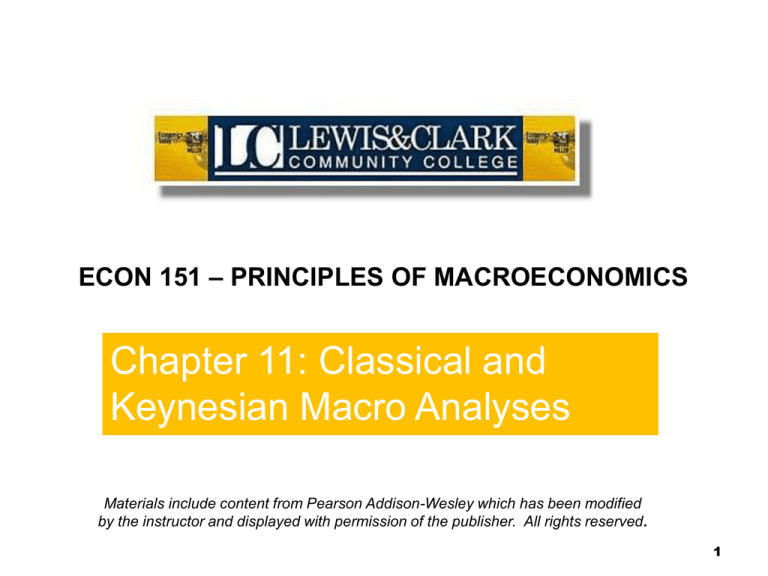
End of
Chapter
10
ECON 151 – PRINCIPLES
OF MACROECONOMICS
Chapter
10
Chapter 11: Classical and
Keynesian Macro Analyses
Materials include content from Pearson Addison-Wesley which has been modified
by the instructor and displayed with permission of the publisher. All rights reserved.
1
1
The Classical Model
The classical model was the first attempt
to explain
Determinants
National
of the price level
levels of real GDP
Employment
Consumption
Saving
Investment
11-2
The Classical Model (cont'd)
Classical economists—Adam Smith, J.B.
Say, David Ricardo, John Stuart Mill,
Thomas Malthus, A.C. Pigou, and
others—wrote from the 1770s to
the 1930s.
They assumed wages and prices were
flexible, and that competitive markets
existed throughout the economy.
11-3
The Classical Model (cont'd)
Say’s Law
A
dictum of economist J.B. Say that supply
creates its own demand
Producing
goods and services generates the
means and the willingness to purchase other
goods and services.
Supply
creates its own demand; hence it follows
that desired expenditures will equal actual
expenditures.
11-4
Figure 11-1 Say’s Law and the
Circular Flow
11-5
The Classical Model (cont'd)
Assumptions of the classical model
Pure
competition exists.
Wages
and prices are flexible.
People
are motivated by self-interest.
People
cannot be fooled by money illusion.
11-6
The Classical Model (cont'd)
Money Illusion
Reacting
to changes in money prices rather
than relative prices
If
a worker whose wages double when the
price level also doubles thinks he or she is
better off, that worker is suffering from money
illusion.
11-7
The Classical Model (cont'd)
Consequences of the assumptions
If
the role of government in the economy is minimal,
If
pure competition prevails, and all prices and wages
are flexible,
If
people are self-interested, and do not experience
money illusion,
Then
problems in the macroeconomy will be
temporary and the market will correct itself.
11-8
The Classical Model (cont'd)
Equilibrium in the credit market
When
income is saved, it is not reflected in
product demand.
It
is a type of leakage from the circular flow of
income and output, because saving withdraws
funds from the income stream.
11-9
The Classical Model (cont'd)
Equilibrium in the credit market
Classical
economists contended each dollar
saved would be matched by business
investment.
Leakages
would thus equal injections.
At
equilibrium, the price of credit—the interest
rate—ensures that the amount
of credit demanded equals the
amount supplied.
11-10
Figure 11-2 Equating Desired Saving and
Investment in the Classical Model
11-11
Equating Desired Saving and
Investment in the Classical Model
Summary
Changes
in saving and investment create a
surplus or shortage in the short run.
In
the long run, this is offset by changes in the
interest rate.
This
interest rate adjustment returns the
market to equilibrium where S = I.
11-12
The Classical Model (cont'd)
Question
Would
unemployment be a problem in the
classical model?
Answer
No,
classical economists assumed
wages would always adjust to the full
employment level.
11-13
Figure 11-3
Equilibrium in the Labor Market
11-14
Classical Theory, Vertical Aggregate
Supply, and the Price Level
In the classical model, long-term unemployment
is impossible.
Say’s law, coupled with flexible interest rates,
prices, and wages would tend to keep workers
fully employed.
The LRAS curve is vertical.
A change in aggregate demand will cause a
change in the price level.
11-15
Figure 11-4 Classical Theory
and Increases in Aggregate
Demand
Classical theorists
believed that Say’s law,
flexible interest rates,
prices, and wages
would always lead to
full employment at real
GDP of $12 trillion
11-16
Figure 11-5 Effect of a Decrease
in Aggregate Demand in the Classical Model
11-17
Keynesian Economics and the Keynesian
Short-Run Aggregate Supply Curve
The classical economists’ world was one of fully
utilized resources.
In the 1930s, Europe and the United States
entered a period of economic decline that could
not be explained by the classical model
John Maynard Keynes developed an
explanation that has become known as the
Keynesian model.
11-18
Keynesian Economics and the Keynesian
Short-Run Aggregate Supply Curve (cont'd)
Keynes and his followers argued
Prices,
including wages (the price of labor)
are inflexible, or “sticky”, downward
An
increase in aggregate demand, AD, will
not raise the price level
A
decrease in AD will not cause firms to lower
the price level
11-19
Keynesian Economics and the Keynesian
Short-Run Aggregate Supply Curve (cont'd)
Keynesian Short-Run Aggregate Supply
Curve
The
horizontal portion of the aggregate supply
curve in which there is excessive
unemployment and unused capacity in
the economy
11-20
Figure 11-6 Demand-Determined Equilibrium Real
GDP at Less Than Full Employment
Keynes assumed
prices will not fall
when aggregate
demand falls
11-21
Keynesian Economics and the Keynesian
Short-Run Aggregate Supply Curve (cont'd)
Real GDP and the price level, 1934–1940
Keynes
argued that in a depressed economy,
increased aggregate spending can increase output
without raising prices.
Data
showing the U.S. recovery from the Great
Depression seem to bear this out.
In
such circumstances, real GDP is
demand driven.
11-22
Figure 11-7 Real GDP and the
Price Level, 1934–1940
11-23
Keynesian Economics and the Keynesian ShortRun Aggregate Supply Curve (cont'd)
The Keynesian model
Equilibrium
GDP is demand-determined.
(Recall that under classical theory according
to Say’s Law, the equilibrium is supply driven
– supply creates its own demand.)
The
Keynesian short-run aggregate supply
schedule shows sources of price rigidities.
Union and long-term contracts explain inflexibility
of nominal wage rates.
11-24
Example: Bringing Keynesian Short-Run
Aggregate Supply Back to Life
New Keynesians contend the SRAS curve is
essentially flat.
Based on research, they contend SRAS is
horizontal because firms adjust their prices
about once a year.
The underlying assumption of the simplified
Keynesian model is that the relevant range of
the short-run aggregate supply schedule (SRAS)
is horizontal.
11-25
Output Determination Using Aggregate Demand
and Aggregate Supply: Fixed versus Changing
Price Levels in the Short Run (cont'd)
The price level has drifted upward in
recent decades.
Prices are not totally sticky.
Modern Keynesian analysis recognizes
some—but not complete—price
adjustment takes place in the short run.
11-26
Output Determination Using Aggregate Demand
and Aggregate Supply: Fixed versus Changing
Price Levels in the Short Run (cont'd)
Short-Run Aggregate Supply Curve
Relationship
between total planned
economywide production and the price level
in the short run, all other things
held constant
If
prices adjust incompletely in the short run,
the curve is positively sloped.
11-27
Figure 11-8 Real GDP Determination with
Fixed versus Flexible Prices
11-28
Output Determination Using Aggregate Demand
and Aggregate Supply: Fixed versus Changing
Price Levels in the Short Run (cont'd)
In modern Keynesian short run, when the price
level rises partially, real GDP can be expanded
beyond the level consistent with its long-run
growth path.
11-29
Output Determination Using Aggregate Demand
and Aggregate Supply: Fixed versus Changing
Price Levels in the Short Run (cont'd)
All these adjustments cause real GDP to rise
as the price level increases
Firms
use workers more intensively, (getting workers
to work harder)
Existing
capital equipment used more intensively,
(use machines longer)
If
wage rates held constant, a higher price level leads
to increased profits, which leads to lower
unemployment as firms hire more
11-30
Shifts in the Aggregate Supply
Curve
Just as non-price-level factors can cause a
shift in the aggregate demand curve, there
are non-price-level factors that can cause
a shift in the aggregate supply curve.
Shifts in both the short- and long-run
aggregate supply
Shifts in SRAS only
11-31
Figure 11-9 Shifts in Both Short- and LongRun Aggregate Supply
11-32
Figure 11-10 Shifts in SRAS
Only
11-33
Table 11-2
Determinants of Aggregate Supply
11-34
Consequences of Changes
in Aggregate Demand
Aggregate Demand Shock
Any
event that causes the aggregate demand
curve to shift inward or outward
Aggregate Supply Shock
Any
event that causes the aggregate supply
curve to shift inward or outward
11-35
Consequences of Changes in Aggregate Demand
Recessionary Gap
The
gap that exists whenever equilibrium real
GDP per year is less than full-employment
real GDP as shown by the position of the
LRAS curve
Inflationary Gap
The
gap that exists whenever equilibrium real
GDP per year is greater than full-employment
real GDP as shown by the position of the
LRAS curve
11-36
Figure 11-11 The Short-Run Effects of Stable
Aggregate Supply and a Decrease in Aggregate
Demand: The Recessionary Gap
11-37
Figure 11-12 The Effects of Stable Aggregate
Supply with an Increase in Aggregate Demand:
The Inflationary Gap
11-38
Explaining Short-Run
Variations in Inflation
In a growing economy, the explanation for
persistent inflation is that aggregate
demand rises over time at a faster
pace than the full-employment level
of real GDP.
Short-run variations in inflation, however,
can arise as a result of both demand and
supply factors.
11-39
Explaining Short-Run
Variations in Inflation (cont'd)
Demand-Pull Inflation
Inflation
caused by increases in aggregate
demand not matched by increases in
aggregate supply
Cost-Push Inflation
Inflation
caused by decreases in short-run
aggregate supply
11-40
Demand Pull Inflation
11-41
Figure 11-13 Cost-Push Inflation
(Stagflation)
11-42
Aggregate Demand and Supply
in an Open Economy
The open economy is one of the reasons
why aggregate demand
slopes downward.
When
the domestic price level rises, U.S.
residents want to buy cheaper-priced foreign
goods.
The
opposite occurs when the U.S. domestic
price level falls.
11-43
Aggregate Demand and Supply
in an Open Economy (cont'd)
Currently, the foreign sector of the U.S.
economy constitutes over 14% of all
economic activities.
11-44
Figure 11-14 The Two Effects
of a Weaker Dollar, Panel (a)
Decrease in the
value of the dollar
raises the cost of
imported inputs.
SRAS decreases.
With AD constant,
the price level rises.
GDP decreases.
11-45
Figure 11-14 The Two Effects
of a Weaker Dollar, Panel (b)
Decrease in
the value of the
dollar makes net
exports rise.
AD increases.
With SRAS
constant, the
price level rises
with GDP.
11-46
End of
Chapter
10
ECON 151 – PRINCIPLES
OF MACROECONOMICS
Chapter
10
Chapter 11: Classical and
Keynesian Macro Analyses
Materials include content from Pearson Addison-Wesley which has been modified
by the instructor and displayed with permission of the publisher. All rights reserved.
47
47

